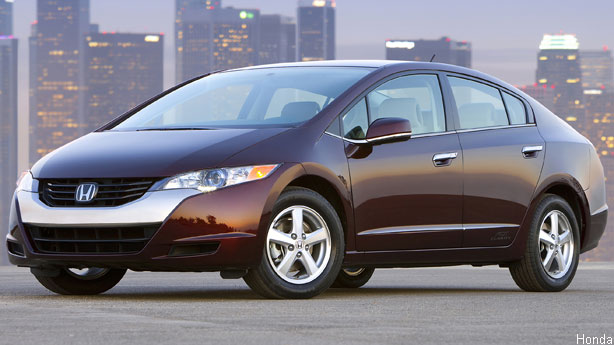
In Translogic Episode 1.3, we heard Stephen Ellis, Honda's Fuel Cell Marketing Manager, talk about how hydrogen can be produced using renewable energy. The way he described it, the FCX Clarity sounds like the perfect green car, one with no environmental impact. But to really understand the situation facing any fuel cell-powered car, it helps to understand a bit more about hydrogen. First of all, hydrogen shouldn't be thought of as a fuel, like oil, gas and other petroleum products. Scientists like to refer to hydrogen as an "energy carrier," which makes a tank of hydrogen seem a lot more like a battery than a tank of gas. Hydrogen doesn't exist in any natural state; it has to be "manufactured," so to speak, by separating it from any number of molecular compounds. In this case, Honda is talking about obtaining hydrogen from water, as "H2O" is made of two hydrogen atoms and one oxygen atom.
At the station where we filled up the FCX Clarity, Ellis said they use electrolysis to produce the hydrogen. This is a process where electricity is used to create a chemical reaction that splits water molecules into separate hydrogen and oxygen atoms. If this electricity comes from sources like wind or solar power, the resultant hydrogen is "green." The FCX Clarity's onboard fuel cell then converts the hydrogen into electricity to power the vehicle without emitting anything more than water vapor.
But if the electricity used to produce the hydrogen comes from power plants that burn fossil fuels like petroleum and coal -- which is where 69 percent of the electricity produced in the US comes from, according to the U.S. Energy Administration -- the FCX Clarity hasn't really eliminated fossil fuel consumption as much as it's just pushed it up the energy chain. There are also serious questions about the efficiency of burning fossil fuels to generate electricity to produce hydrogen, which is then converted back into electricity in the car.
But rather than heading down that rabbit hole, let's consider a more immediate complication to Honda's perfect scenario: Hydrogen isn't usually produced via electrolysis. According to a Department of Energy report, 80 percent of commercial hydrogen is produced by steam methane reforming, largely because this is the least expensive method. Water electrolysis is only a niche market. Steam methane reforming works by splitting hydrogen atoms from natural gas, which has the unfortunate downside of producing, uh oh, carbon dioxide as a waste material. Remember, the EPA is now officially considering CO2 and other greenhouse gasses as pollutants.


Sign in to post
Please sign in to leave a comment.
Continue